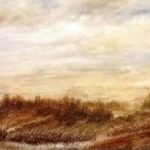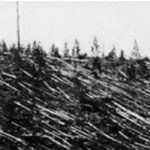
Lichens look like splashes of paint left behind by a careless painter. Unlike many plants, they do not require soil to grow. They grow on the bark of trees in steaming tropical rain forests, on farmers' fenceposts, on the bricks of big-city buildings, and on old gravestones. Lichens can tolerate extremes of climate. They grow on rocks in hot springs, on wind-swept mountain-top boulders, and on stones in the driest deserts. In the Arctic, lichens, known as reindeer moss, are the principal source of food for caribou. Whole mountainsides in Antarctica appear green and orange because of the presence of lichens; they are one of the few plants that can survive there. They are among the oldest of known plants. Recently, scientists discovered lichen fossils on a rock in a phosphate mine in southwest China that dated back 600 million years.
When conditions become harsh, lichens become dormant. If there is not enough moisture, they simply dry up, but a short rain or even a heavy dew gives them new life. When growing on rock surfaces, lichens secrete acids that dissolve the minerals, contributing to the process of weathering by which rocks are slowly turned to soil. This property enables lichens to be pioneers. They appear on barren rock scoured clean by glaciers, fires, lava flows, or floods, beginning the process of soil formation that allows mosses, ferns, and other plants to later take root. But, despite their hardiness, lichens are extremely sensitive to airborne particles. That's why they serve as an early warning system for air pollution.
It is the acids lichens produce that give them their distinctive colors. Lichens are often spoken of in the same breath as mosses, and some lichens are even called mosses, but true mosses are all distinctively green, whereas lichens appear in many vivid colors. At one time, before the invention of aniline dyes, acids from lichens were used to make dyes, such as the purple dye orchil, the blue dye litmus, and the red dye cudbear, and they are sometimes still used that way today. Some lichens, such as oak moss, contain oils that produce fragrant odors used in scented soaps, cosmetics, and perfumes. Some lichens are also known to have antibiotic properties.
Lichens are a partnership of two or more types of plants, a fungus and a type of algae. [A] If you look at the lichen body through a magnifying glass, you will see that it is made up of a tangled mass of fungal strands called hyphae. [B] In the upper layer of these hyphae grow colonies of another type of plant. [C] These are most commonly green algae but are sometimes blue-green algae. [D]
The two types of organisms live together to the benefit of both, a relationship known as symbiosis. The fungus provides support for the algae and protects the tender algae from direct sunlight and dry air. The fungus provides moisture and minerals for the plant. The fungus also produces chemicals which, when combined with alcohol produced by the algae, form acid crystals. This acid carves tiny holes in rocks and other substances, and the fungus inserts threads (not true roots) into these holes to anchor the plant in place. The algae contain chlorophyll and synthesize sugars from carbon dioxide and sunlight, producing food for the lichen. A chemical secreted by the fungus softens the cell walls of the algae and allows nutrients to pass from the algae to the fungus.
There are many examples of symbiosis in nature, but lichens are unique because they look and behave differently from their components. The algal components of lichen can live independently and are recognizable as species that grow alone. The fungal components, on the other hand, cannot live apart from their partners. They can be placed in known families of fungi but are unlike any species that live independently.
So definite are the form, color, and characteristics of these double organisms that for hundred of years lichens were classified as one. More than 15,000 species were named. If these organisms are classified as single species, it is difficult to fit them into the existing system of classification. But if they are classified as separate species, these fungal species that cannot live alone seem rather strange. Lichens, then, are a splendid example of the difficulties faced by taxonomists in classifying species.
*fungus: a non-green, plant-like organism such as a mushroom that feeds on dead or living plants
*algae: a simple plant that usually lives in water
*chlorophyll: a chemical that enables plants to photosynthesize (use sunshine in creating food)





